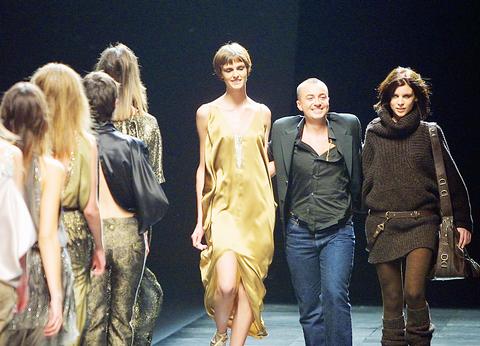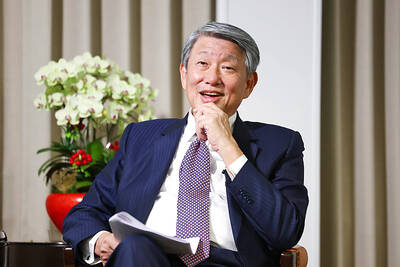Welsh designer Julien Macdonald changed gear with a raunchy ready-to-wear collection for Givenchy on Saturday featuring distressed biker gear and slinky evening gowns in metallic tones of bronze, slate and rust.
Motorcycle girls took a ride through Elizabethan England in petrol blue and copper fitted leather jackets with cupped collars and trousers that flared out like bloomers before tapering into narrow boots. To a soundtrack of Rod Stewart's "Do ya think I'm sexy?," models paraded in billowing capes with cowls tucked under trilby hats in the display on the third day of Paris fashion week, which also featured shows by Jean-Paul Gaultier and Cacharel.

PHOTO: AP
Macdonald turned his back on the humble fabrics featured in his first show for Givenchy last season, replacing cotton jersey and canvas with sumptuous silk, velvet and fur. After all, who wants to spend hundreds of dollars on a simple cotton vest?
However, he didn't go all the way back to his roots as a purveyor of barely there dresses for pop stars like the Spice Girls. At Givenchy, the glamour was more subtle, with plunging shifts in liquid black satin with diamante details.
There was only one problem with this approach -- Givenchy is still struggling to establish a clear identity, unlike Dior and Louis Vuitton, its stablemates at the luxury conglomerate LVMH.
French designer Jean-Paul Gaultier aired his dirty laundry in a witty show that had models stripping off coats and jackets to hang them on a sliding dry cleaner's rail.
The display opened with a dressmaker's bust and empty hangers emerging from a clear plastic curtain and circling the catwalk hanging from the central rail fixed overhead.
As models stepped out, they peeled off their outer layers and draped them on the hangers, although the effect was more akin to an art exhibition than to a laundry rack.
Gaultier paid homage to environmental artist Christo, famed for wrapping landmarks such as the Pont Neuf in Paris and the Reichstag in Berlin, by wrapping and padding his models like parcels in luxurious layers of wool and silk.
Nylon waistcoats puffed out like life jackets, while silk scarves were bound over chiffon dresses to sensual effect.
"The clothes were a bit dirty so we sent them to the laundry -- ha ha ha! It's my beautiful launderette!" an exuberant Gaultier told reporters backstage.
British design duo Clements Ribeiro played it safe at Cacharel with a prim collection featuring prints by textile designer Celia Birtwell, the former wife and creative collaborator of 1960s British designer Ossie Clark.
Leaves were scattered over knee-length skirts and ladylike pussy bow blouses, while graphic prints gave a modern edge to floaty chiffon tunics and tank tops trimmed with ribbed jersey.
Birtwell changed the face of fashion with designs that were worn by style icons like Veruschka and the Beatles.
Her collaboration with the husband-and-wife team of Inacio Ribeiro and Suzanne Clements is likely to give Cacharel added cachet among London's hip crowd, although whether traditional clients will appreciate its significance is another matter.
Clements Ribeiro have had to tone down their edgier concepts for the label's stores in provincial France. As with most fashion houses, the real money-spinner is perfume and Cacharel has developed a new fragrance to go with its revamped image.
"Gloria," a spicy Oriental, launches on April 15 with a TV ad campaign set to the Patti Smith rock anthem of the same name.

Nvidia Corp CEO Jensen Huang (黃仁勳) today announced that his company has selected "Beitou Shilin" in Taipei for its new Taiwan office, called Nvidia Constellation, putting an end to months of speculation. Industry sources have said that the tech giant has been eyeing the Beitou Shilin Science Park as the site of its new overseas headquarters, and speculated that the new headquarters would be built on two plots of land designated as "T17" and "T18," which span 3.89 hectares in the park. "I think it's time for us to reveal one of the largest products we've ever built," Huang said near the

China yesterday announced anti-dumping duties as high as 74.9 percent on imports of polyoxymethylene (POM) copolymers, a type of engineering plastic, from Taiwan, the US, the EU and Japan. The Chinese Ministry of Commerce’s findings conclude a probe launched in May last year, shortly after the US sharply increased tariffs on Chinese electric vehicles, computer chips and other imports. POM copolymers can partially replace metals such as copper and zinc, and have various applications, including in auto parts, electronics and medical equipment, the Chinese ministry has said. In January, it said initial investigations had determined that dumping was taking place, and implemented preliminary

Intel Corp yesterday reinforced its determination to strengthen its partnerships with Taiwan’s ecosystem partners including original-electronic-manufacturing (OEM) companies such as Hon Hai Precision Industry Co (鴻海精密) and chipmaker United Microelectronics Corp (UMC, 聯電). “Tonight marks a new beginning. We renew our new partnership with Taiwan ecosystem,” Intel new chief executive officer Tan Lip-bu (陳立武) said at a dinner with representatives from the company’s local partners, celebrating the 40th anniversary of the US chip giant’s presence in Taiwan. Tan took the reins at Intel six weeks ago aiming to reform the chipmaker and revive its past glory. This is the first time Tan

CUSTOMERS’ BURDEN: TSMC already has operations in the US and is a foundry, so any tariff increase would mostly affect US customers, not the company, the minister said Taiwanese manufacturers are “not afraid” of US tariffs, but are concerned about being affected more heavily than regional economic competitors Japan and South Korea, Minister of Economic Affairs J.W. Kuo (郭智輝) said. “Taiwan has many advantages that other countries do not have, the most notable of which is its semiconductor ecosystem,” Kuo said. The US “must rely on Taiwan” to boost its microchip manufacturing capacities, Kuo said in an interview ahead of his one-year anniversary in office tomorrow. Taiwan has submitted a position paper under Section 232 of the US Trade Expansion Act to explain the “complementary relationship” between Taiwan and the US